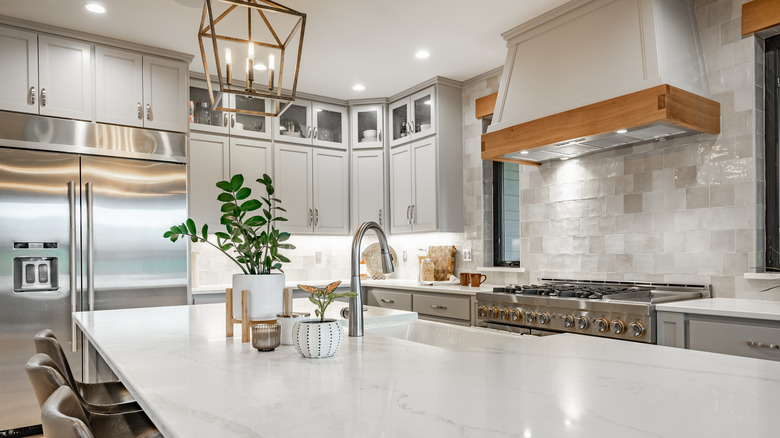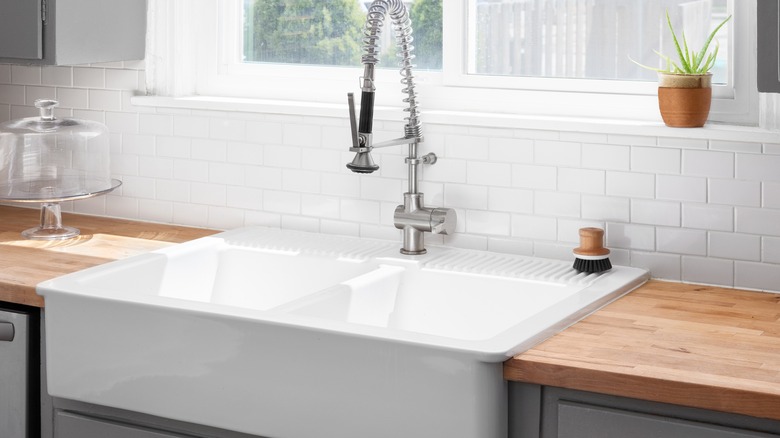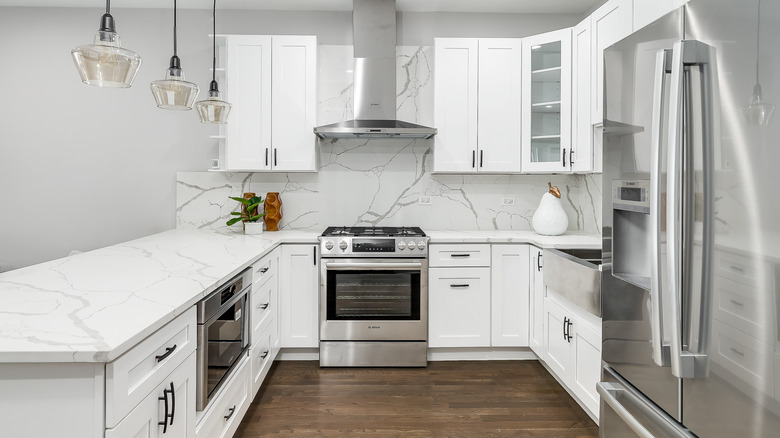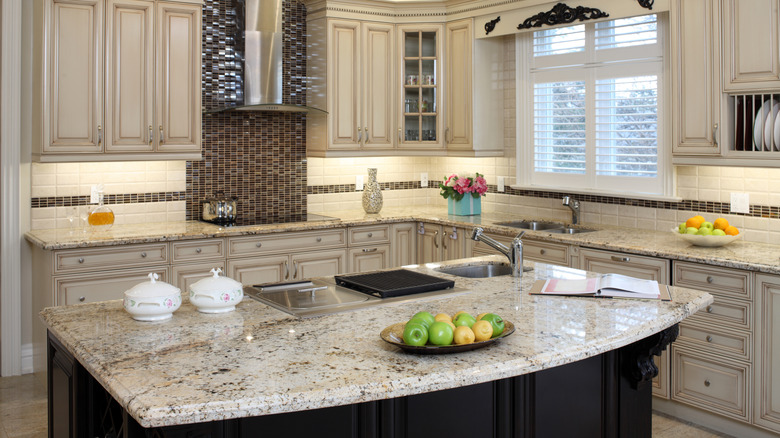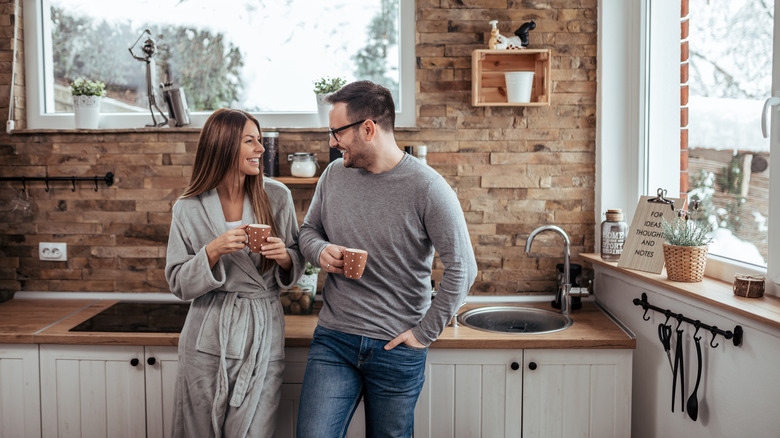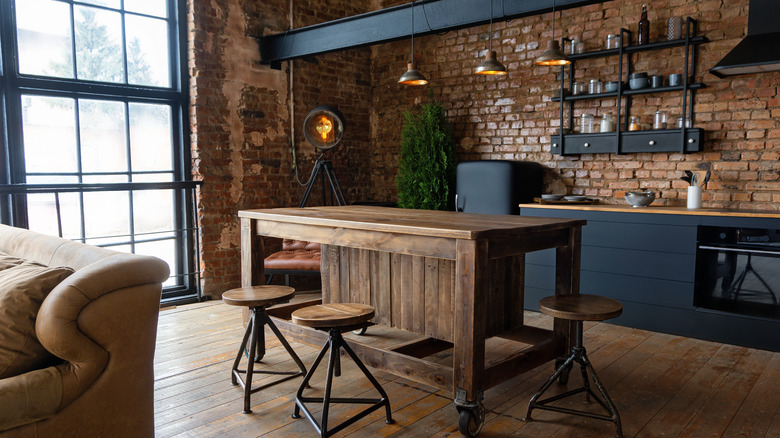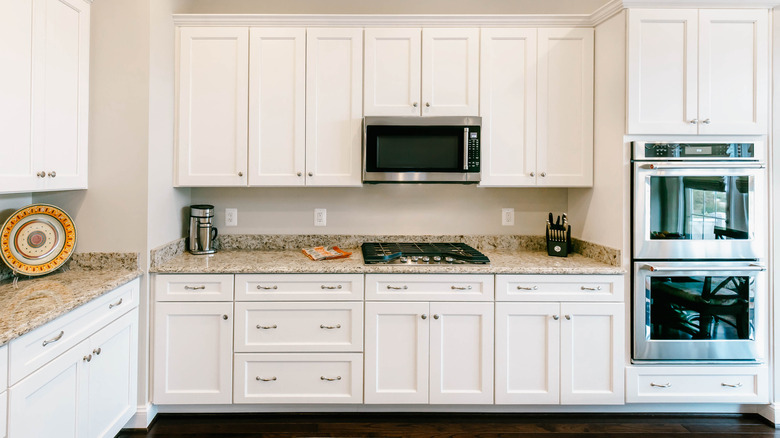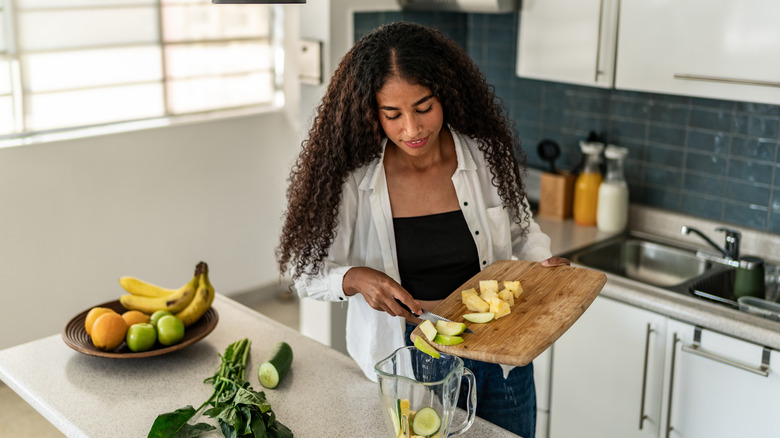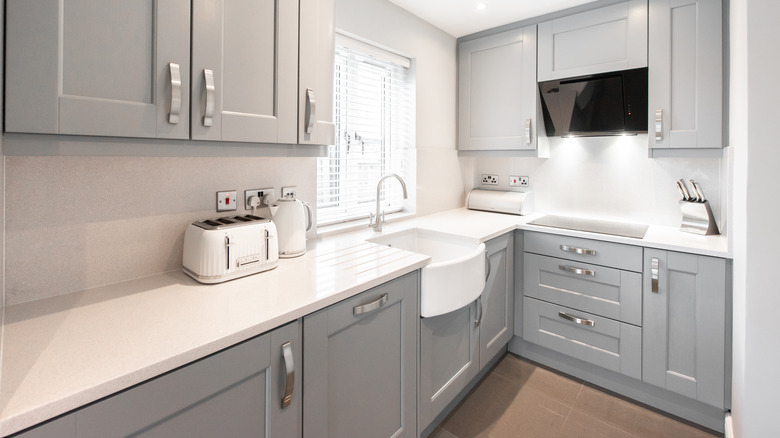Outdated Kitchen Design Trends Being Replaced In 2024
Design is a constantly evolving thing. Not only does that keep things fresh (and keep stores in business,) but it also evolves as needs change. The kitchen used to be an industrial part of the house, where you would tuck away to do the hard work of cooking. But as the decades passed, it morphed into a communal space where family and guests can gather around and connect while dinner is being made. This has completely changed the look of the room, morphing it from a small, closed space in the back of the house to a large, open area in the heart of the home. But that doesn't mean it has stopped evolving. The things that were important to us in 2024 are changing as 2025 quickly approaches, and because of that, certain trends are waning to accommodate new needs. To figure out what those trends are, we asked interior designers to share what is beginning to feel passé, and what is replacing them.
For instance, all-white kitchens became all the rage in the early 2020s, just as the realities of the pandemic took hold. People not only wanted airy, bright spaces to lift their moods, but also sterile rooms that felt especially clean and pristine. As the pandemic years are now behind us, folks are craving more natural, warmer elements to make the home feel cozier. However, that's not to say that you should rip out your all-white kitchen — especially if you still love the look. But if you feel like your kitchen feels off and you want a change, here are some of the trends that are marching toward the "outdated" category.
Farmhouse sinks are beginning to feel too bulky
When Joanna Gaines took the world by storm in the early 2010s with her shiplap walls, reclaimed wood kitchen islands, and Americana flea market finds, people quickly followed suit. Whether you lived in the Midwest or the East Coast, fans of the style scrambled to recreate a decidedly Southern aesthetic. It didn't matter that you lived in a condo in Ohio or a McMansion in Vermont — if you wanted your home to look like a southern farmhouse, you could use Gaines' staples to recreate that look. And part of that look was using large farmhouse sinks. There was nothing cozier than a farmhouse kitchen with a giant farmhouse sink and old-timey faucet acting as the centerpiece. But as more people move towards more contemporary designs (including Gaines herself!) the farmhouse sink is beginning to fall out of favor. "Farmhouse sinks are losing popularity as their bulky design can dominate the kitchen space and doesn't fit well with more modern, sleek designs," Cristiana Crin, Founder and Director of Design at Perpetuum Designs, exclusively tells House Digest.
Nowadays, people want the sink to blend in with the room rather than stand out in it, which leads to an interesting design replacing the large basins. "Integrated sinks that blend seamlessly with the countertop are becoming more popular, offering a more streamlined and contemporary look," Crin explains. These are sinks made out of the same material as your countertop, and they're built right into it, removing any visible seams. So, if you have a marble countertop, you also have a marble sink; if you have a concrete countertop, you have a concrete sink, and so on.
All-white kitchens are starting to look cold
All-white kitchens have been the predominant kitchen design for the last decade, and it seems that people have had their fill of them. While all-white kitchens will always be timeless to a point (they have been around since the early 20th century after all,) trends are moving away from the typical bright white cabinets paired with white subway tiles and white quartz countertops. "The all-white kitchen is losing its appeal as it can feel too sterile and lacks personality," Crin explains. While it might have made us feel safe during the pandemic — when having a visibly clean and airy space felt grounding — needs have since changed.
Instead, people are moving toward more biophilic, cozier designs. "Warm, earthy tones and natural materials like wood and stone are becoming more popular, creating a cozy and inviting atmosphere," she notes. This is part of a larger trend, where more and more designs are being warmed up with earthy accents. For instance, the farmhouse aesthetic is moving away from its black and white motif and is being integrated with white oak, reclaimed wood accents, marble, travertine, and so on. Part of the reason we're craving to bring the outside in has to do with our increasingly online reality. Since the pandemic, more people have begun to work, go to school, and create content online, making us live an increasingly digital life. This has created a need to be more rooted in the real world. This back-to-nature aesthetic also extends to the kitchen, where all-white kitchens are infused with contrasting wooden islands, zellige tiles in warmer hues, or white oak flooring to give it a touch more coziness.
Granite countertops are becoming old-fashioned
Granite countertops were the go-to countertop material from the late 1980s to the 2000s, and is still relatively popular with certain design aesthetics, such as traditional or transitional kitchens. However, as more millennials and Gen Zers enter the housing market, the material is waning in popularity as it's seen as something from their parents' kitchens. "Granite is being phased out because it is seen as dated and requires more maintenance," Crin explains.
Instead, people want not only something fresher, but also something easier to take care of and clean. "Quartz and composite materials are trending due to their durability, low maintenance, and wide range of color options," Crin says. These materials can withstand high heat, food spills, scratch marks, and are a breeze to clean with a wide range of products. You don't have to be precious with them. And since they are synthetically made, you also have a wider range of color options, veining, and veining placement. For example, while you can't control the natural speckling or color blend in granite, you can request busier or more minimalist veining in quartz, since a fabricator can simply create it.
Faux finishes look a little too faux
People have always rolled up their sleeves and tried to DIY upgrades in their homes, but that seemed to skyrocket during the pandemic. As people were cooped up in their homes for weeks, if not months, at a time, they looked to occupy their time with projects. This not only kept them busy, but also helped transform their environment into something pleasant to spend time in — especially in the kitchen, which is seen as the heart of the home. Having a builder-grade kitchen was fine when you spent most of your day in an office and then post-work meetups with friends or family. But it became deeply unsatisfying when you began to see it day in and day out. That's when faux finishes started to skyrocket, with people experimenting with things like faux stone, fake wood, shiplap, and so on. But things are beginning to change. "Faux finishes, like faux wood and faux stone, are falling out of favor because they can appear cheap and artificial," Crin warns.
While they served a purpose — and were fun to DIY — folks are beginning to upgrade to the real deal. "Authentic materials are preferred, with homeowners opting for genuine wood, stone, and high-quality laminates that offer a more genuine look and feel," she explains. This might be partly due to the rise of the biophilic design trend. As we want to bring the outside in, it might feel unsatisfying to touch faux wood or see artificial stone. Instead, more and more people want the real deal.
Industrial style is starting to feel uninviting
There was a time when living in a loft seemed like the ultimate design aesthetic. Exposed ceilings, brick walls, and large black frame windows created a metropolitan look that felt fresh and unexpected. But unless you're living in an actual loft, the look has less cache today. "The industrial style, characterized by exposed brick, metal, and concrete, is becoming less popular as it can feel too cold and uninviting," Crin notes. As styles are trending towards warmer, back-to-nature designs, utilizing something so factory-made feels less palatable.
"A shift towards more organic and biophilic designs is occurring, incorporating natural elements and greenery to create a more balanced and serene environment," she explains. However, that's not to say that industrial elements are being taken completely off the menu. Instead, they're being mixed with these warmer designs. For instance, stainless steel countertops are being contrasted with rich, amber wood cabinets, or concrete flooring is combined with wooden cabinets and stone backsplashes. Rather than relying heavily on just one trend, there is a push to mix multiple ones to create something truly unique and homey.
Microwaves above your range are now an eyesore
For a kitchen to be efficient, it needs to be conveniently arranged, which is why the microwave has been placed near or above the range for decades. If you're cooking something on the stovetop and need to heat something quickly, you can just pop it in above you. But as more and more people are putting an onus on aesthetics, the microwave is being tucked away from view. "Over-the-range microwaves are becoming a thing of the past, as more clients are opting for sleek microwave drawers that tuck neatly beneath the countertop," Amanda Wyatt, interior designer and founder of Design Insider, exclusively tells House Digest.
That's because people want to focus less on utilitarianism and more on design. "Microwave drawers blend seamlessly into the kitchen design, creating a cleaner, more streamlined look while maintaining functionality and accessibility," she explains. It's yet another appliance that you can integrate and blend into the space, which leads us to our next point.
Seeing the kitchen as one-dimensional is short-sighted
The kitchen used to be a place where you did the hard work of preparing a meal, and it was designed with utility in mind. Nowadays, cooking is more of a communal event, and people like to gather around the island as one person cooks. "Homeowners are starting to see their kitchens as more than just a place to cook — they're becoming the go-to spot for hanging out and entertaining," Wyatt explains. Because of this, it has not only grown in size and adopted an open floor plan, but the furniture we're adding to it has become more living room-like. "To create a more inviting vibe, people are extending their kitchen areas with cozy seating, like sofas or lounge chairs, so guests can relax while meals are being made. Bars and coffee nooks are also popular additions, giving everyone a spot to grab a drink or coffee and chat."
But that's not all. For those who have the space, they're taking it even further by adding in an extra "entertaining" island," or double kitchen island. "Second islands are shifting from food prep stations to places where people can sit and enjoy a casual meal or conversation," she notes. For those who really love to entertain, they're also finding new uses for their walk-in pantries. "Some homeowners are even taking it a step further by expanding their pantries into larger, more versatile spaces, complete with sofas or chairs, making it a comfortable place to lounge." The kitchen is morphing into a multi-functional space where people are encouraged to gather, hang out, connect, and lounge, all while you chop and cook. And the design now reflects that.
Lower kitchen cabinets aren't as practical as drawers
Another kitchen staple that now feels outdated is lower cabinets. No, they're not being replaced by open shelving, much like how upper cabinets have been. Instead, they're being swapped out in favor of drawers. This all has to do with practicality. With shelves, it's difficult to see what's stored in the very back. Since they're typically 24 inches deep, you can store a great deal in their cavities, but whatever is pushed to the back and stored nearest the wall is often forgotten about until your annual clean-out and reorganizing. To solve this, more and more people are opting for sturdy pull-out drawers.
These drawers can hold everything from small kitchen appliances to pots and pans to overflow pantry items. Some reinforced ones can also hold heavy stacks of plates and bowls. And since you can pull them out, you are able to see their entire contents at a glance, even the items stored at the very back. It's also much easier to put things away, since you don't have to crouch down to put them on shelving. Instead, you can just open the drawer and lower them in. This convenience makes updating your lowers with drawers a no-brainer, causing lower shelving to be slowly phased out.
